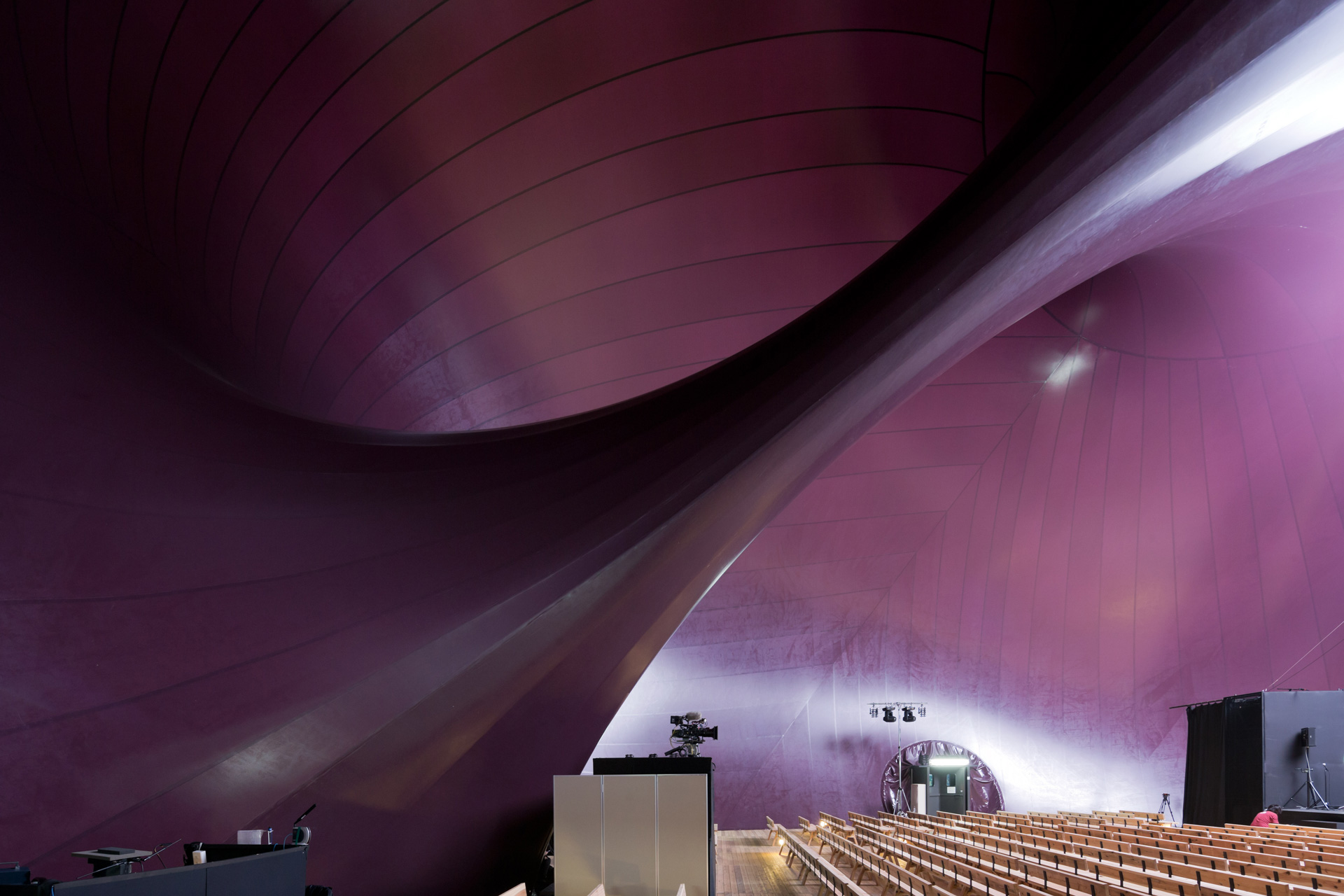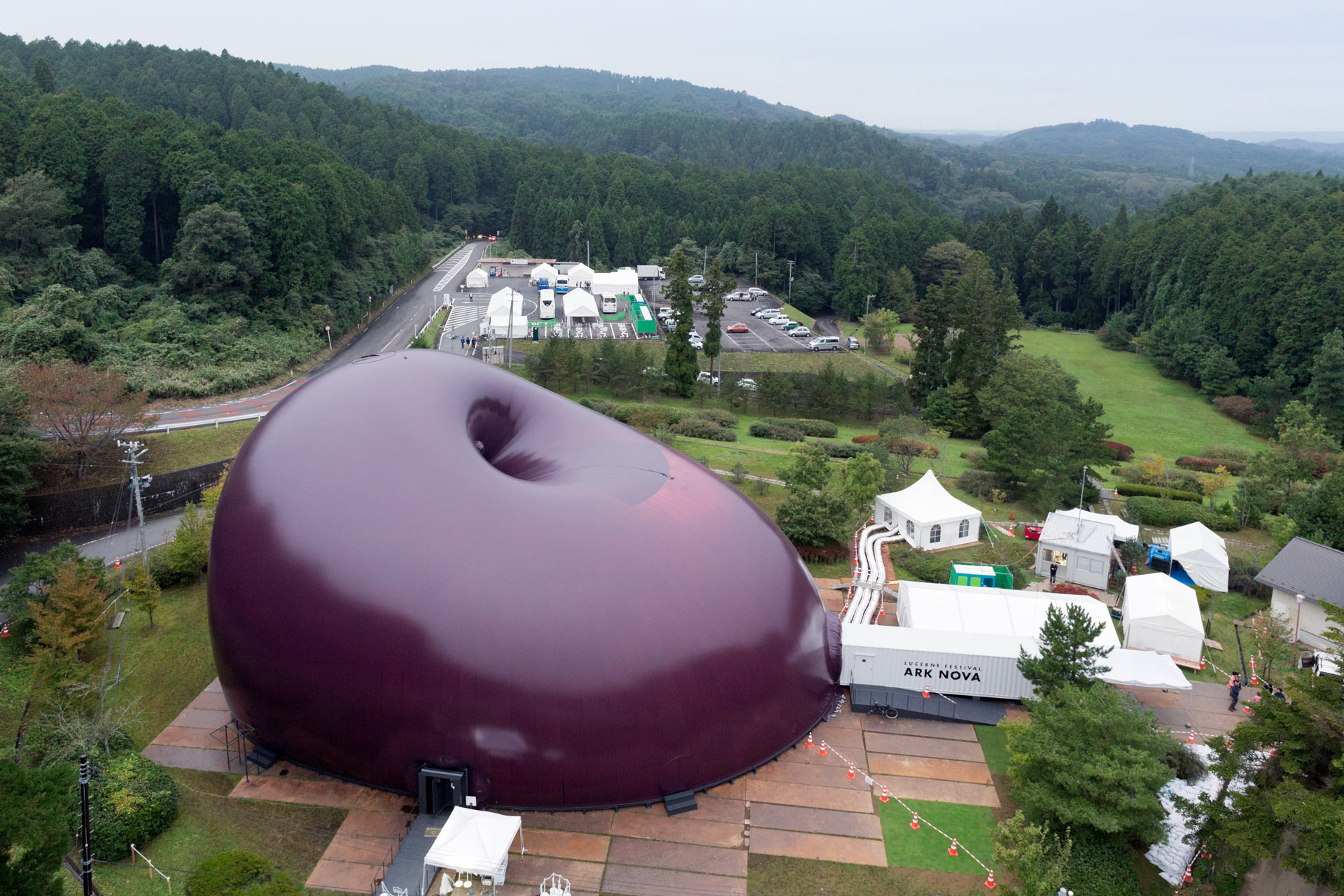-

Photos: Iwan Baan
Pump up the Volume
Arata Isozaki and Anish Kapoor’s inflatable concert hall
The Ark Nova inflatable concert hall was conceived in the aftermath of the 2011 tsunami in Japan. It is a reusable venue designed to tour the most badly affected areas, supplementing a still patchy live arts provision for the local population. The project was initiated by the Lucerne Festival, a Swiss international music event that traditionally has strong links to Japan. It takes its inspiration from Noah’s Ark pitching up after the biblical flood, though it does not carry “people and animals to escape from disaster” – as the Festival’s artistic director Michael Haefliger puts it – but is “packed with music and various arts” for the “long-term rebuilding of culture and spirit”.
-
Arata Isozaki, born 1931 in Ōita, Japan, studied architecture at the University of Tokyo, graduating in 1954. After working in the office of Kenzo Tange, he established his own firm, Arata Isozaki & Associates, in 1963. He has since built around the world including in Europe, Central Asia, the Middle East, China and North America. Celebrated projects include the Museum of Contemporary Art (MOCA) in Los Angeles (1981-86) and the Kyoto Concert Hall (1991-95). In 2005, Arata Isozaki founded an Italian branch of his office, Arata Isozaki & Andrea Maffei Associates. A current project includes an office tower in the new CityLife Business District of Milan. He was awarded the RIBA Gold Medal in 1986.
Anish Kapoor, born 1954 in Bombay, India, has lived and worked in London since moving there in the early 1970s to study art at the Hornsey College of Art, then at the Chelsea School of Art.
He represented Britain in the 44th Venice Art Biennale in 1990 and was awarded the Turner Prize in 1991. Celebrated projects since include his 2002 Unilever Commission Marsyas in the Turbine Hall at the Tate Modern, Cloud Gate in Chicago's Millennium Park; Leviathan at the Grand Palais in Paris in 2011; and ArcelorMittal Orbit, commissioned as a permanent artwork for London's Olympic Park in 2012. He received a knighthood in 2013.

The design of the building, looking somewhat like a giant plum, is a cooperation between Japanese architect Arata Isozaki and Indian-born, London-based artist Anish Kapoor. At 30 metres wide, 36 metres long and 18 metres high, its structure is a lightweight translucent purple membrane, inflated by a series of air pumps in around two hours – which can be deflated, folded up and loaded onto a truck for easy transportation between venue sites. It provides a flexible space that can accommodate audiences of up to 500 and all types of stagings and performances: from traditional orchestral concerts to in-the-round multi-stage contemporary music events.
With acoustics an important consideration, airlocks isolate the hall from the noise of the pumps, whilst a floating “acoustic cloud” bounces sound back down to the audience. This is supplemented by a more traditional method: cedar wood reflectors behind the stage. These, like the seating, are made with timber from the tsunami-damaged forests around the Zuiganji Temple, a symbol of the city of Matsushima, the first venue for the concert hall in October 2013. A tour of the region is still under preparation. I (rgw)
-
Search
-
FIND PRODUCTS
PRODUCT GROUP
- Building Materials
- Building Panels
- Building technology
- Façade
- Fittings
- Heating, Cooling, Ventilation
- Interior
- Roof
- Sanitary facilities
MANUFACTURER
- 3A Composites
- Alape
- Armstrong
- Caparol
- Eternit
- FSB
- Gira
- Hagemeister
- JUNG
- Kaldewei
- Lamberts
- Leicht
- Solarlux
- Steininger Designers
- Stiebel Eltron
- Velux
- Warema
- Wilkhahn
-
Follow Us
Tumblr
New and existing Tumblr users can connect with uncube and share our visual diary.
»I hate vacations. If you can build buildings, why sit on the beach?«
Philip Johnson
Keyboard Shortcuts
- Supermenu
- Skip Articles
- Turn Pages
- Contents


